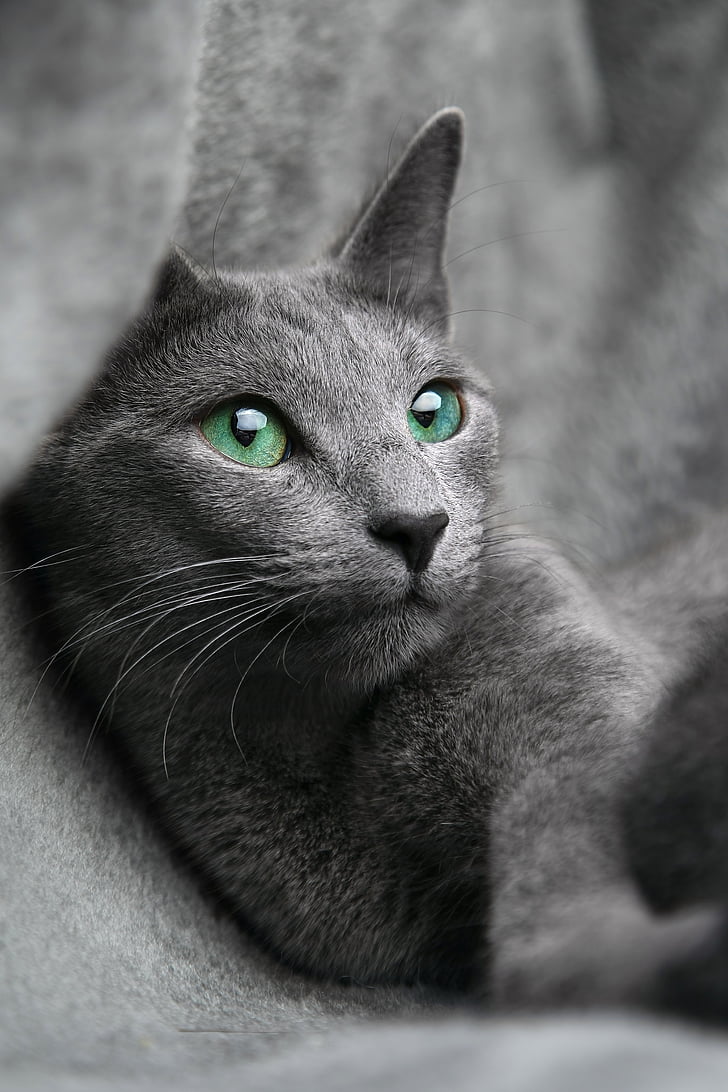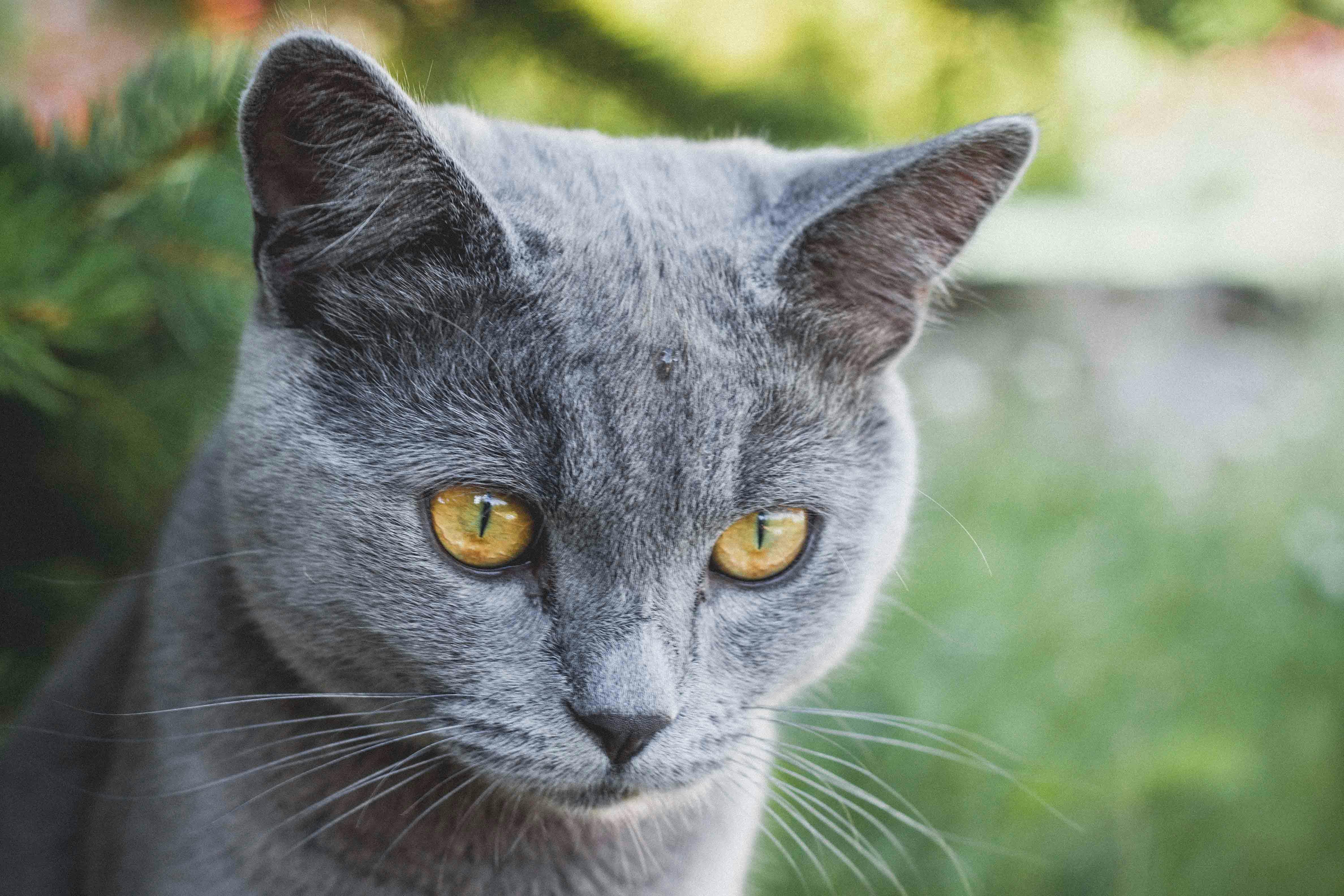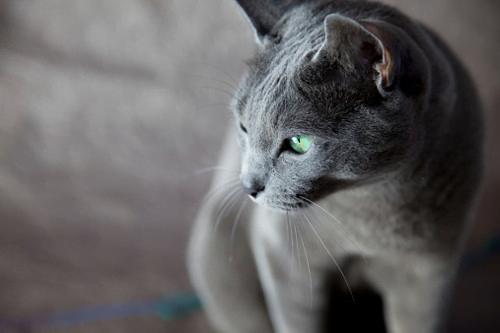The Russian Blue, a cat breed with a storied history and distinctive features, captivates enthusiasts worldwide. Originating from Russia, this breed is renowned for its plush blue coat, striking green eyes, and gentle demeanor. Known for their intelligence and loyalty, Russian Blues make ideal companions for families and individuals alike. They possess a shy nature around strangers but are affectionate and playful with their owners. Their hypoallergenic fur makes them a preferred choice for people with allergies. This breed’s elegant appearance combined with its endearing personality explains why it holds a special place in the hearts of cat lovers everywhere.
Key Takeaways
- Russian Blues are a unique breed with a distinct silvery-blue coat and green eyes, making them not only beautiful but also a popular choice for cat enthusiasts.
- They require moderate care, including regular grooming and attention to their diet, to maintain their health and stunning appearance.
- Living with a Russian Blue means enjoying a quiet, gentle companion who values loyalty and can be quite affectionate with their family.
- When looking to adopt a Russian Blue, seek reputable breeders or adoption agencies that can provide health clearances and background information on the cat.
- Understanding the breed’s specific needs and personality traits is crucial for creating a harmonious living environment and a strong bond between the cat and its owner.
- Engaging with the Russian Blue’s playful yet reserved nature can lead to a rewarding companionship filled with mutual respect and affection.
Breed Overview
History
The Russian Blue cat traces its origins to Russia’s northern regions. It is believed that sailors brought these cats to Europe in the 1860s. The breed quickly gained popularity for its striking appearance and gentle demeanor. In England, Russian Blues were exhibited at cat shows by the late 19th century, marking their formal recognition.
Their popularity crossed the Atlantic, making them beloved in the United States as well. However, World War II nearly decimated the breed. Post-war efforts focused on preserving and reviving their lineage proved successful. Today, Russian Blues are celebrated worldwide for their history and unique characteristics.
Physical Characteristics
One cannot discuss Russian Blues without mentioning their silvery-blue coat. This coat is thick, plush, and stands out for its shimmering quality. Their body structure is elegantly slim with fine bones and long legs, giving them a graceful appearance.
Their bright green eyes are captivating. These eyes are not just beautiful but also expressive, adding to the breed’s allure.
Personality and Temperament
Russian Blues are known for their gentle nature. They tend to be shy around strangers but do not mistake this for aloofness. Once comfortable, they show immense loyalty and affection towards their family members.
They possess a high level of intelligence and curiosity. This makes them quick learners who enjoy interactive toys and games that challenge their minds.

Health And Care
Common Health Issues
Russian Blues are known for their good health and long lifespan. However, they can have genetic predispositions to certain conditions. Dental issues are common in the breed, requiring owners to pay extra attention to oral hygiene. Kidney problems have also been noted but can often be managed with proper care and regular veterinary oversight.
Regular check-ups play a crucial role in preventing these health issues. They help catch potential problems early on. With attentive care, these elegant felines can enjoy a robust life, often living well into their late teens or even early twenties.
Dietary Needs
A balanced diet is essential for maintaining the Russian Blue’s sleek physique. Overfeeding can lead to obesity, a concern for this breed due to their efficient metabolism. Owners should focus on high-quality cat food that supports their overall health and contributes to the shine of their distinctive coat.
Specific nutrients like omega-3 fatty acids are beneficial for their coat’s condition and general well-being. Portion control and consistency in feeding routines prevent weight gain while ensuring they receive all necessary vitamins and minerals.
Exercise Requirements
Despite their calm demeanor, Russian Blues need daily playtime for physical and mental stimulation. Interactive toys that mimic prey, such as laser pointers or feather wands, cater to their hunting instincts and keep them engaged.
Exercise is not just fun; it’s vital for preventing obesity in these agile cats. A combination of solo activities that they can pursue on their own and interactive play sessions helps maintain their fitness levels and fosters a strong bond between pet and owner.
Grooming
The Russian Blue’s coat is unique because it lacks an undercoat, making it low maintenance compared to other breeds. Weekly brushing suffices to remove dead hair and distribute skin oils evenly throughout their fur, keeping it glossy.
Besides coat care, regular nail trimming prevents overgrowth and discomfort. Ear cleaning should also be part of the grooming routine to avoid wax build-up and infections. These practices ensure the Russian Blue remains healthy, happy, and beautiful.
Living with a Russian Blue
Training and Socialization
Russian Blues are remarkably intelligent cats. This intelligence makes them quite receptive to training. Positive reinforcement, like treats and praise, works well with them. They learn quickly, especially when their sharp minds are engaged.
Early socialization is crucial for these cats. It helps them overcome their natural shyness around strangers. Introducing them to different people, pets, and environments early on can make a big difference.
Activities that challenge their brains are important. Puzzle toys, learning tricks, or even simple games that require problem-solving can keep their mental agility sharp. Such stimulation is key to their happiness and well-being.
Environment
A calm and stable environment suits Russian Blues best. They tend to be sensitive to loud noises or sudden changes in their living situation. Maintaining a peaceful home helps keep them relaxed and content.
Providing safe outdoor access or a secure balcony can greatly benefit these curious creatures. It allows them exploration opportunities without exposing them to the dangers of roaming freely outside.
They also appreciate cleanliness in their living space more than most. A clean litter box and tidy surroundings reflect on their own need for cleanliness. It’s part of keeping them healthy and happy, as discussed in the “Health And Care” section.
Activities They Enjoy
Russian Blues enjoy a variety of activities that engage both their bodies and minds. Fetch, puzzle toys, and interactive play sessions can provide the mental stimulation they crave.
They also love high perches and climbing structures. These allow them to observe their surroundings from a safe vantage point—a behavior deeply ingrained in their nature.
Setting up a daily routine of playtime and relaxation is beneficial. It matches their energy levels perfectly, ensuring they’re neither bored nor overly stimulated.

Breeder Advice and Adoption
Choosing a Breeder
When searching for a Russian Blue kitten, finding a reputable breeder is crucial. These breeders place a high priority on the health and temperament of their cats. They ensure that each kitten is a well-adjusted, healthy member of your family. It’s important to ask for health clearances. This proves the kitten’s parents are free from genetic diseases common to the breed.
Visiting the breeder’s facility is also key. It lets you see the environment where the kittens grow up. You can observe how they interact with their littermates and humans. This visit offers valuable insights into their early socialization practices.
Adoption
Adoption is a noble alternative to buying a Russian Blue from a breeder. Many shelters and rescue organizations have Russian Blues or similar breeds waiting for homes. They often come from situations where they can no longer be cared for by their previous owners.
To identify a Russian Blue in a shelter, look for their distinctive features like a sleek, blue-gray coat, bright green eyes, and a gentle demeanor. Shelter staff can help point out cats that match these traits or have known backgrounds as Russian Blues.
Adopting an adult cat has its perks. Many are already socialized and trained, making the transition to your home smoother. Adult cats often get overlooked in shelters, but they can make just as loving and rewarding companions as kittens.
Misc.
Popular Names
Russian Blues, with their elegant demeanor and distinctive coat, inspire a range of names. Owners often choose names like Sasha, Misha, and Anastasia to honor their Russian heritage. These names reflect the breed’s noble appearance and mysterious allure.
For their striking looks, names such as Shadow, Smokey, and Silver are popular choices. They capture the cat’s sleek, blue-gray coat perfectly.
Gender-neutral options like Alexi, Nikita, and Sky have also found favor among Russian Blue enthusiasts. These names suit the breed’s sophisticated and gentle nature well.
Fun Facts
Russian Blues boast an intriguing history filled with tales of royalty and luxury. Rumor has it these cats were once the favored pets of Russian tsars. Their regal bearing seems to support this claim.
In arts and literature, they’re often depicted as symbols of mystery and elegance. This highlights their significant cultural impact over time.
One unique trait is their quiet voice; they prefer to communicate with expressive eyes and subtle body language. This sets them apart from more vocal breeds.
Common Myths
Contrary to popular belief, Russian Blues are not hypoallergenic. While they may produce fewer allergens than some breeds, no cat is truly hypoallergenic.
Another myth is that all blue or grey cats are Russian Blues. In reality, specific features like a double coat and bright green eyes distinguish them from other breeds.
The idea that Russian Blues require special care is also unfounded. They are adaptable and resilient cats that thrive in various environments without needing extraordinary care.
Most Similar Breed
When comparing Russian Blues to other blue-coated breeds, British Shorthairs come to mind first. However, British Shorthairs have a more robust build and a laid-back temperament compared to the slender and agile Russian Blue.
Nebelungs share similarities with Russian Blues but differ in coat length—Nebelungs have longer fur—and personality traits; Nebelungs can be shyer.
To distinguish a Russian Blue from similar breeds, look for its fine short coat, vivid green eyes, and distinctive mauve paw pads—traits unique to this elegant breed.

Top Cat Grooming Tools (Click Here)
Conclusion
The Russian Blue stands out as a breed with a rich history, notable health resilience, and unique temperament, making it an ideal pet for families and individuals alike. Its low-maintenance coat and ability to form strong bonds with its owners have contributed significantly to its popularity. Prospective pet owners should consider adopting from reputable breeders or rescue organizations to ensure the well-being of these majestic creatures. The journey of living with a Russian Blue offers a blend of affection, tranquility, and companionship that enriches the lives of those who choose to welcome this breed into their homes.
As enthusiasts continue to cherish and promote the welfare of the Russian Blue, it remains crucial to prioritize responsible breeding practices and adoption efforts. By doing so, the legacy and purity of the breed are preserved for future generations to enjoy. Those interested in becoming part of the Russian Blue community are encouraged to seek further information and connect with established groups or clubs dedicated to this enchanting breed.
Frequently Asked Questions
What is the lifespan of a Russian Blue cat?
Russian Blue cats typically live between 15 to 20 years. Proper care, nutrition, and regular veterinary check-ups contribute to their longevity.
How do I care for a Russian Blue’s coat?
Their dense, plush coat requires minimal grooming. Weekly brushing is sufficient to remove loose hair and maintain its lustrous sheen.
Are Russian Blues good with children and other pets?
Yes, Russian Blues are known for their gentle and friendly nature. They usually get along well with children and other pets if introduced properly and early.
What health issues should I be aware of in Russian Blues?
Russian Blues are generally healthy, but they can be prone to genetic conditions like bladder stones and heart issues. Regular vet visits are essential for early detection and management.
How can I find a reputable Russian Blue breeder?
Look for breeders who provide health clearances for both parents and allow visits to see the kittens’ living conditions. A reputable breeder prioritizes the health and socialization of their kittens.
Can Russian Blues adapt to apartment living?
Absolutely. Russian Blues are relatively quiet and can thrive in apartment settings as long as they have enough space for play and exploration.
Is it better to adopt or buy a Russian Blue cat?
Adoption is a great option if you’re looking to provide a home to a cat in need. However, purchasing from a reputable breeder ensures knowledge about the cat’s genetic history and temperament.






0 Comments